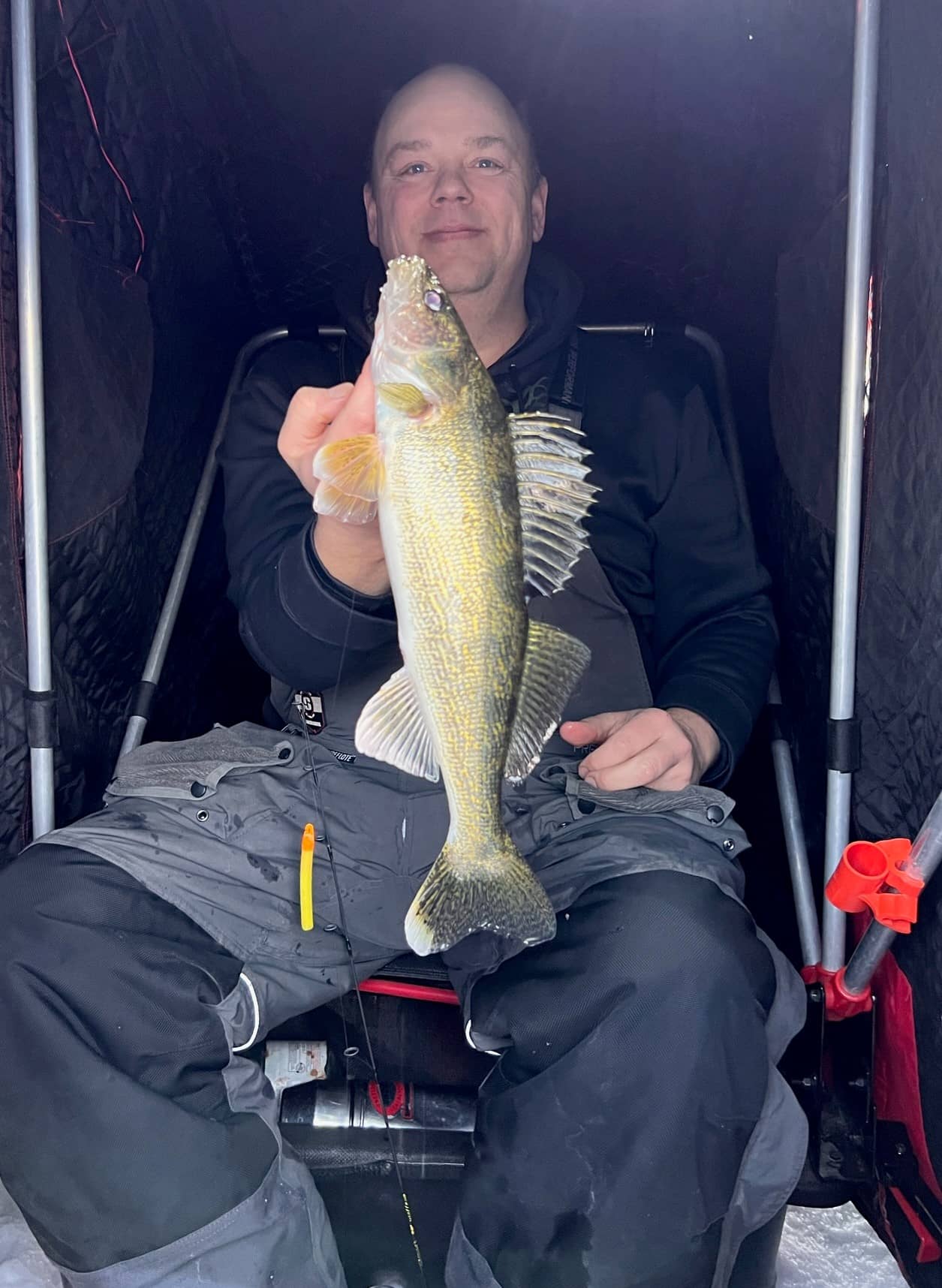
On Screen, IRL. The author’s friend, Josh Holm of Valley City, ND, with a walleye pulled up from under the ice and observed by the author on high-end sonar the whole time. Simonson Photo.
By Nick Simonson
As cellular phone technology began to creep into every corner of life, I worked hard to keep it out of my outdoor adventures. Before smartphones even, when a gray LCD display lit by a greenish white backlight was the only glow a phone provided, the old pay-by-the-minute Nokia model I owned often stayed in my truck while I walked the fields or ventured out on the ice. I was not only reluctant to keep it out of the experience, I was adamantly opposed to it being part of it, even if it meant things were a little bit safer.
“Who would want to take a call in the middle of a hunt or a fishing outing,” I often wondered, and chided anyone who picked up their buzzing unit in my boat or behind my dog to get their honey-do list for the drive home or field an angry client call, ruining the end of a perfectly good outing.
As the technology became more ubiquitous though, and our world became more connected, my models advanced and my use of them – sometimes regrettably and sometimes advantageously – increased, even in the outdoors. From the gray-screened Nokia base model to a Blackberry with its little glowing trackball, to the touch screen of several iPhone installments, I have found reassurance in their presence, should something ever go wrong outdoors. Strangely enough, with them in tow, it never has.
When I have to check a regulation, find a boundary, or snap a photo, most times they’re connected with a click to find the information I need or ready to preserve the memory. In those moments of boredom on stand or slow stretches on the ice too, the mental crutch is there to pass the time with a quick article, some doom scrolling or the launching of little birds at green pigs. Their screens have become as much a part of life – regrettably, and advantageously, once again – as seemingly food, water and breath are in our modern era.
Long before I lost the smart device versus the outdoors debate with myself, however, one screen was a permanent fixture in my icehouse: a Vexilar FL-8. I had the sonar unit four years before my first mobile phone graced my jacket pocket. Hitting the hardwater without it was out of the question, and I didn’t begin my on-ice adventures until the day after Santa left it below my stocking that winter. This precursor to technology dependance in the outdoors was an easy concession when piles of perch, stacks of pike, and buckets of walleyes made their way home with me as a result. Since that time, I’ve gone through three models: trading up to the FL-20 and then the FLX-28, each with their zoom enhancements, and the latter with increased target separation.
By today’s standards however, they are the Nokia phone or maybe the Blackberry, as live display sonar units complete their technological takeover on the ice. Sitting in my brother’s pop-up shelter this weekend, watching the drift of debris and small baitfish down river in real time, and the occasional walleye and pike creep along the bottom or zoom into view on his display, I thought of how far we have come in the last 20 years with screen technologies in the outdoors. In the same breath, he lauded the abilities of the unit in his efforts but cursed every other angler with the wherewithal to buy one of the multi-thousand-dollar screens for theirs, and how quickly fish moved, were caught, and disappeared when a bite started and seemingly ended in a hot minute, due in part to the technology we were enjoying. We laughed the discussion off as a nearby buddy brought a walleye up in a hole adjacent to us and we watched the battle unfold underwater as clearly as a football game on TV.
Cell phones notwithstanding in this whole debate, I’ll never ice fish without a screen, aside from a few trips as a kid before the technology existed. I always have and always will. I don’t know if I’m up for dropping a semester of my kids’ college tuition on one, but we’ll see where the price point is in a few seasons.
On the sliding scale of outdoor activities, sonar on the ice works wonders in upping the odds for success. The benefits can’t be denied on openwater either, and whether it’s a portable base unit or something more sophisticated; for trolling sonar is almost a necessity in identifying productive stretches, picking out fish, and increasing success. However, when working summer docks for bass, fly fishing rivers, or just angling structure I know holds crappies or smallies, I rarely give the readout a second thought. As for that pocket-sized device in the field, my phone stays silent, referred to only for guidance on boundaries and hunt-related information. Should it ever buzz or ring through with an unknown number, or perhaps a known one signaling work, I have the option to push the decline button, and keep the sliding scale for technology intact…in our outdoors.
